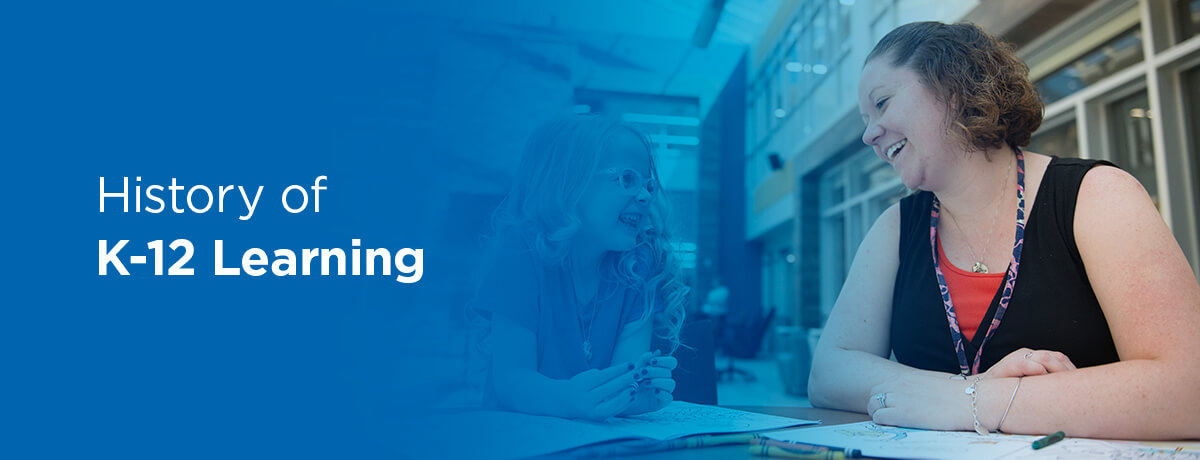2025-2026 School Year Enrollment Now Open. Click Here
2025-2026 School Year Enrollment Now Open. Click Here

The kindergarten through grade twelve (K-12) educational system in the United States was created almost 200 years ago to provide all children with an equal opportunity to attend school. Although it’s changed over the years, K-12 learning is nearly the same public education system that most people experience today. The goal for K-12 schools is to provide a high-quality education for all. Let’s dive into the history of learning in K-12 academics and how it has evolved.
The K-12 educational system is the 13-grade academic structure that public schools follow in the United States. The abbreviated name stands for kindergarten through 12th grade. It was created to ensure all children earn an education — ideally for 13 years. Each state has a department of education that determines the length of compulsory education, which is how long students must attend school. For example, in Pennsylvania, students must attend school from ages 6 to 17, though they can attend as early as 5 and until age 21.
The K-12 system is typically broken down into three stages — elementary school, middle school, and high school. The focus of K-12 public schools is to provide a well-rounded education in core subjects like math, science, English, language arts, and social studies. Depending on their state’s policies, students might also need to take physical education, world languages, technology, and art courses.
Leading up to the 19th century, getting an education was a luxury that only the wealthy could afford. The founding fathers believed that educating the population was crucial to the success of the American democracy they were trying to build. They proposed a unified system of federally funded schools as an investment that would benefit the whole nation. The first U.S. public high school was established in 1821 in Massachusetts, and in the 1830s, the state’s legislator Horace Mann advocated for free, universally available public schools.
Horace Mann was named the Father of the Common School for his contribution to major educational reforms in the 19th century. He’s one of the most famous public education advocates, believing that education should be free, universal, and accessible to all. His beliefs were fueled by the idea that widespread national education would lead to political stability and social harmony.
He led the Common School Movement that advocated for state-funded public schools so all children could become educated and productive citizens. Within a few decades, common schools were established throughout most northern and midwestern states.
Horace Mann believed that the key to improving the quality of rural schools was investing in teacher education. He played a crucial role in developing the first teacher training facilities known as normal schools. His efforts paved the way for the K-12 public education system that we know today.
Since its invention almost two centuries ago, the K-12 educational system has been adapted many times to meet societal changes. The most recent challenge is the need for skilled labor. Nearly three-quarters of the fastest-growing occupations require more than a high school diploma. To meet this need, K-12 schools must focus on preparing students to succeed in higher education or post-high school training.
Let’s take a look at how U.S. schools have changed over the last decade to accommodate this need:
With the growing need for postsecondary education, high schools and career and technical education (CTE) programs have shifted to prepare students to earn a degree or postsecondary certificate after graduation. The goal is to help students identify specific careers of interest and develop the path they can follow — be it college, technical school, or job training — to expand their career options.
Science, technology, engineering, and mathematics (STEM)-related occupations have grown significantly over the last decade. Schools are working to improve the delivery and impact of STEM curricula to meet the growing need for STEM professionals.
Since calculators and computers were introduced to the classroom in the 1970s, new technology has transformed public schools into more versatile and effective learning environments. Computer labs are a staple in all public schools, but recently one-to-one device programs have provided entire classes with electronic devices for lessons and activities. These programs have positively impacted test scores, student engagement, student-teacher collaboration, and instruction quality over the last decade.
All parents should have the authority to choose the school that works best for their child, whether that’s a public, private, or charter school. The freedom to choose allows parents to select a school that matches their child’s specific educational needs.
Charter schools are rising in popularity for offering the inclusivity and affordability of a public school with the adaptability and specialized education of a private school. Since 2005, charter schools have increased their share of public students from 2.1% to 6.5%.
The K-12 learning structure applies beyond traditional public schools. It’s modeled in a variety of institutions, such as:
Commonwealth Charter Academy is a K-12 public cyber charter that offers unique benefits for students. As a public school, we offer free and accessible education to children in any school district across Pennsylvania. The cyber charter aspect allows us to provide flexible and personalized learning that isn’t possible in a traditional brick-and-mortar institution.
We utilize the power of technology to provide a customized education from the comfort of home. Students can attend school from anywhere at almost any time while pursuing other hobbies and passions. They can learn at their own pace when it works best for their family, making high-quality education truly accessible for everyone.
Contact CCA today for more information about our unique approach to K-12 education.
2025-2026 School Year Enrollment Now Open. Click Here